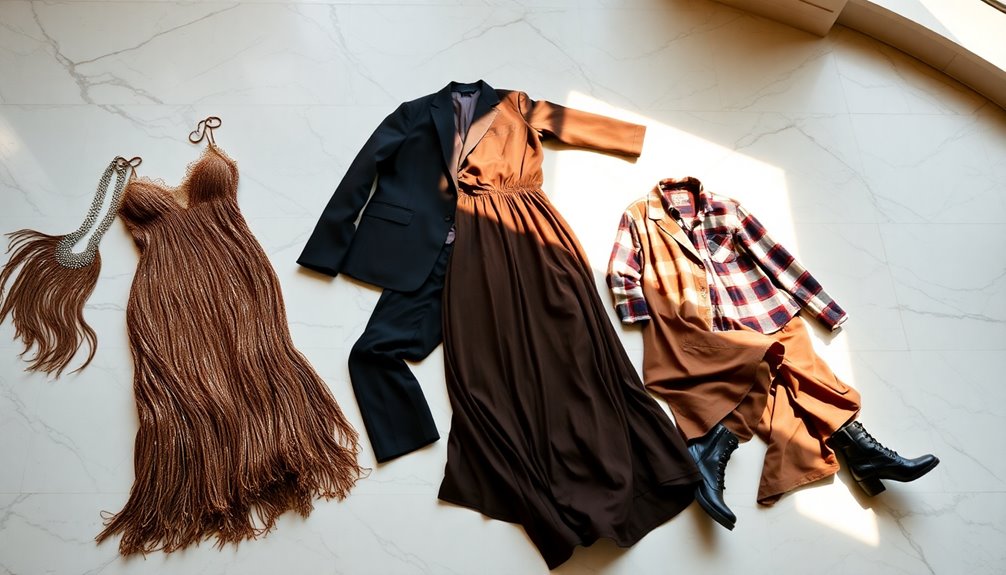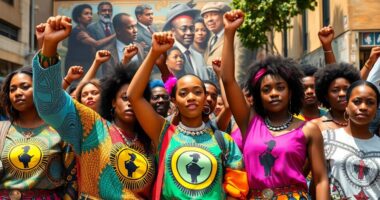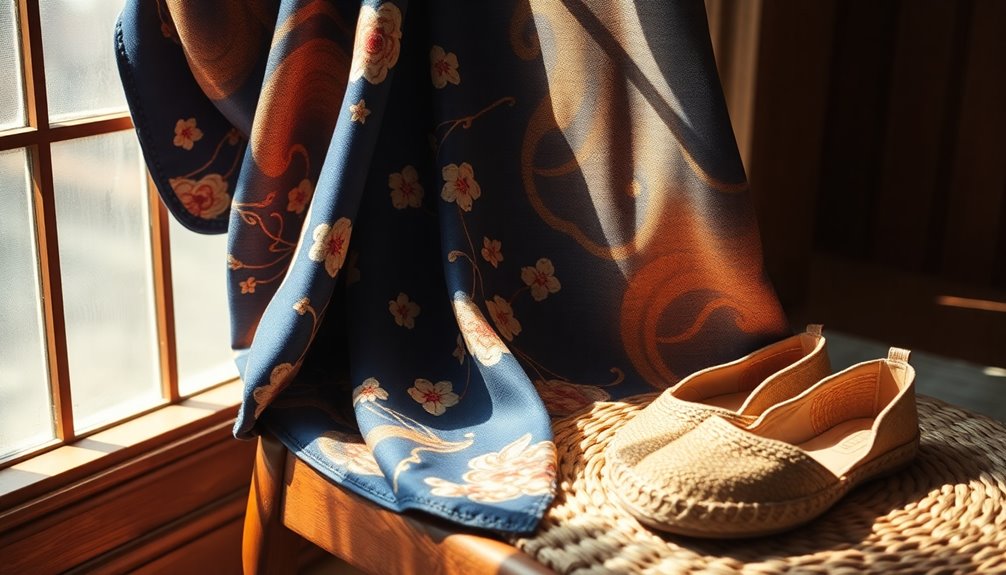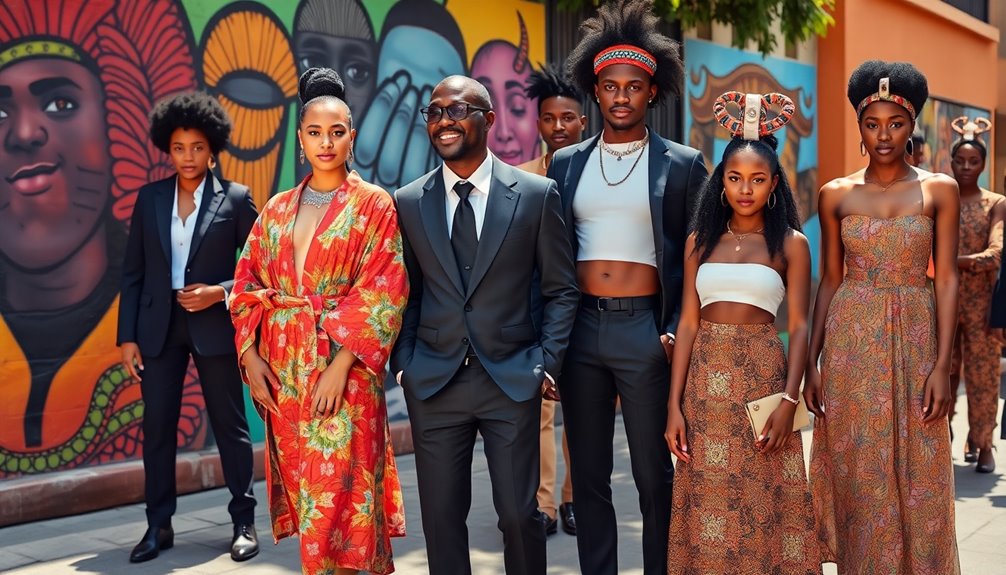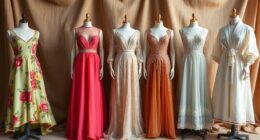Cultural movements have greatly shaped iconic fashion looks, reflecting the spirit and values of their times. From Coco Chanel's Little Black Dress, which empowered women, to Christian Dior's New Look reviving post-war femininity, each style tells a story. Surrealism introduced imaginative fashion, while the grunge movement showcased rebellion against norms. The rise of power dressing in the 1980s transformed women's workplace attire, asserting their presence in male-dominated fields. Today, sustainability trends focus on ethical practices and eco-friendly materials, signaling a shift in consumer consciousness. Explore how these elements intertwine and influence today's fashion landscape.
Key Takeaways
- Paul Poiret's artistic approach to fashion in 1911 established creativity and marketing, influencing the role of designers in cultural movements.
- Coco Chanel's Little Black Dress symbolized women's independence and challenged traditional norms, reflecting the cultural shift towards egalitarian principles in the 1920s.
- The Surrealist movement, exemplified by Elsa Schiaparelli's collaborations with artists, infused dream-like elements into fashion, reshaping cultural perceptions of style and art.
- Christian Dior's "New Look" post-World War II celebrated femininity, uplifting spirits and influencing social movements focused on empowerment and luxury.
- The rise of digital platforms and influencer culture in recent years reshaped consumer engagement, reflecting contemporary cultural shifts towards accessibility and instant gratification in fashion.
The Birth of Modern Fashion
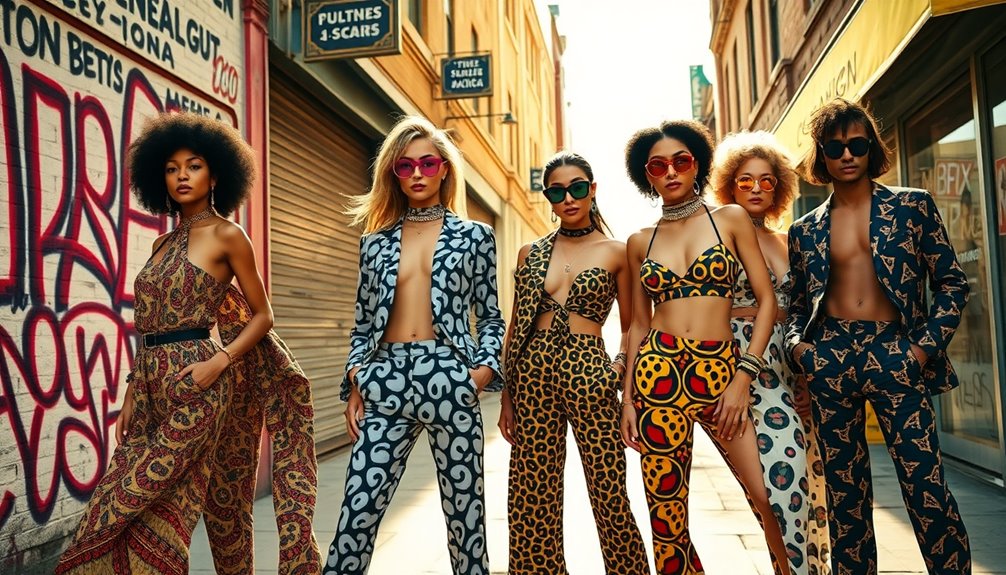
The birth of modern fashion can be traced back to 1911, when Paul Poiret transformed the industry by treating it as an art form. He broke away from societal norms and Victorian ideals, embracing liberation and comfort in his designs.
By introducing the first fashion editorial shot by Edward Steichen for Art et Décoration magazine, Poiret set a new standard in fashion history. His use of celebrity ambassadors and extravagant society balls paved the way for contemporary fashion shows.
Furthermore, launching a perfume line marked a significant shift in branding, influencing future collaborations between designers and beauty products. Poiret's innovative approach laid the groundwork for the fashion industry we recognize today, where creativity and marketing go hand in hand.
The Little Black Dress Revolution
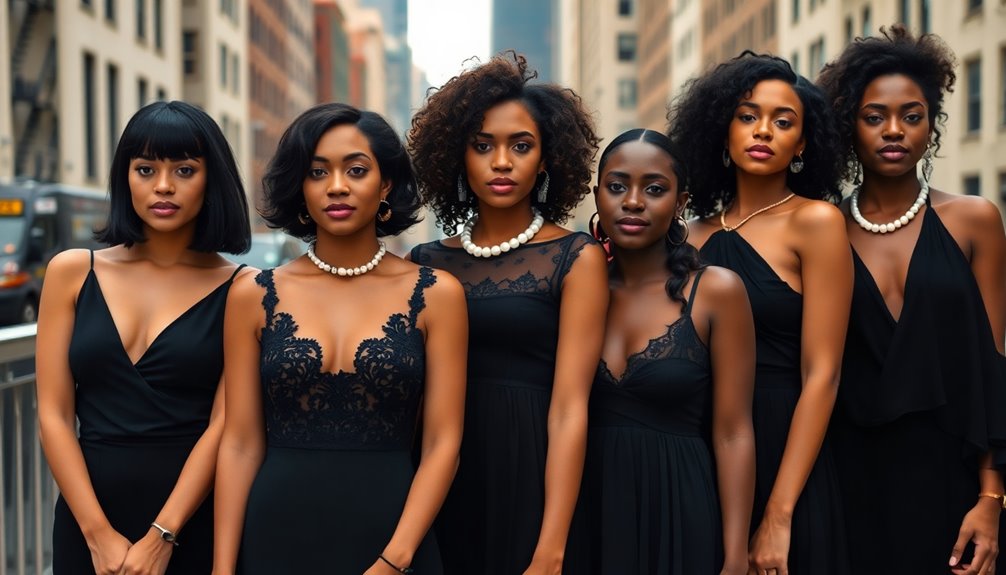
Coco Chanel's introduction of the Little Black Dress (LBD) in 1926 marked a revolutionary moment in women's fashion, building on the artistic foundation laid by Paul Poiret.
The LBD challenged traditional class norms, symbolizing a shift towards egalitarian principles in fashion choices. Featured in American Vogue, Chanel's knee-grazing black dress redefined black from a color of mourning to one of elegance, embodying the rebellious spirit of the Roaring Twenties.
It represented women's newfound independence, liberating them from restrictive fashion norms. With its simplicity and versatility, the LBD became suitable for various occasions, solidifying its status as a timeless classic.
Its cultural significance transcended fashion, empowering generations of women and influencing designers worldwide.
Surrealism's Influence on Fashion
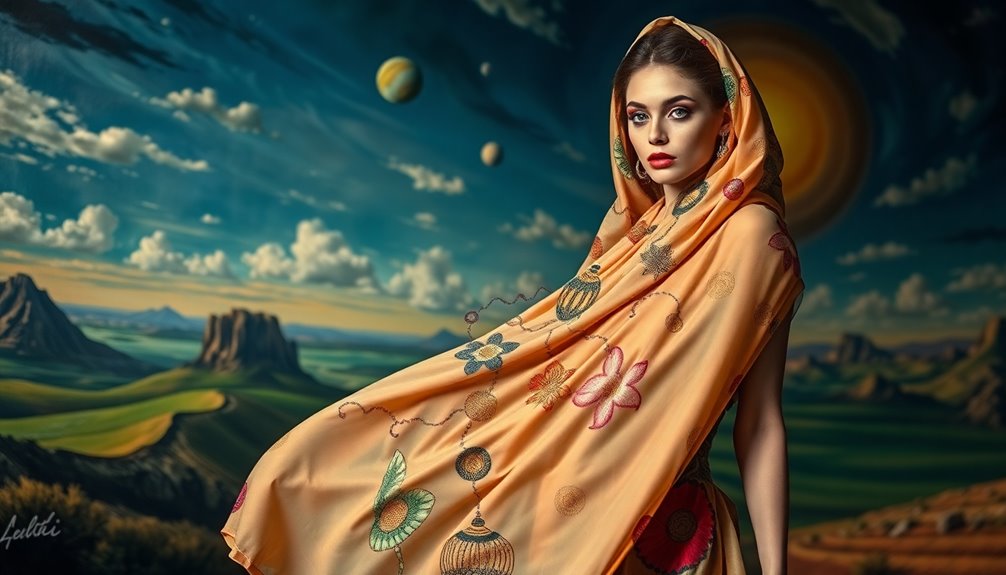
While traditional fashion often adhered to established norms, surrealism boldly redefined the landscape by infusing imaginative elements into clothing.
Visionary fashion designer Elsa Schiaparelli exemplified this shift in the 1930s, collaborating with artists like Salvador Dalí. Her creations, such as the iconic lobster dress and the innovative flask dress, showcased whimsical elements and unexpected combinations.
Surrealism encouraged you to embrace dream-like imagery and manipulate form, resulting in unconventional silhouettes that challenged traditional aesthetics. This movement blurred the lines between fashion and fine art, positioning clothing as a powerful form of artistic expression.
Post-War Femininity and The New Look

After the war, you might notice how Christian Dior's "New Look" transformed feminine silhouettes with its cinched waists and voluminous skirts, celebrating a return to elegance.
This shift not only reflected the post-war economic boom but also shaped women's fashion in ways that resonated for decades.
As you explore the impact of this iconic style, consider how it both reinforced and challenged traditional gender roles in society.
Feminine Silhouettes Redefined
As the dust of World War II settled, Christian Dior's "New Look" emerged in 1947, redefining feminine silhouettes and revitalizing women's fashion. This collection celebrated luxury and femininity with cinched waists and full skirts, contrasting sharply with wartime austerity.
The impact on fashion was profound, as Dior introduced 90 distinct silhouettes that uplifted women's spirits and reinstated traditional femininity.
Here's what you experienced with the "New Look":
- A shift from utilitarian styles to elegance.
- Renewed confidence in personal identity.
- Paris reestablished as the fashion capital.
- A lasting legacy of feminine elegance.
Dior's innovation not only transformed clothing but reshaped societal attitudes towards women's fashion, influencing generations to come. The emphasis on luxury and femininity resonates similarly to the trend of using natural sweetening alternatives found in popular honey brands.
Post-War Economic Influence
The "New Look" not only transformed fashion but also mirrored the post-war economic landscape, where newfound prosperity fueled a desire for luxury and elegance. Christian Dior's designs celebrated femininity, shifting from wartime austerity to a focus on opulence. This shift re-established Paris as a fashion capital, influencing styles worldwide.
| Aspect | Description |
|---|---|
| Luxury | Emphasis on haute couture |
| Silhouettes | Over 90 designs showcasing femininity |
| Consumer Spending | Increased after the economic boom |
| Social Impact | Influenced various social classes |
| Global Influence | Set standards for decades in fashion |
As women sought to express their newfound freedoms, the "New Look" molded the world of fashion, embodying a collective yearning for renewal. This cultural resurgence paralleled the rise of solar energy innovations, reflecting a broader trend towards embracing modernity and sustainability.
Lasting Impact on Fashion
While the fashion landscape was forever changed by Christian Dior's 1947 "New Look," its influence extended far beyond mere aesthetics. This revolution in fashion celebrated femininity, offering women a fresh sense of identity after the war.
The "New Look" not only redefined women's silhouettes but also ignited significant social movements that emphasized empowerment and elegance.
Here are some lasting impacts of this iconic style:
- Reestablished haute couture as a dominant force.
- Sparked a cultural shift towards opulence and elegance.
- Increased the popularity of fashion magazines and shows.
- Inspired women globally to embrace their femininity.
Dior's designs uplifted spirits and set a new standard, forever changing how fashion reflects social movements. This transformative era parallels the importance of community seen in ancient cultures, where collective values shaped societal norms.
Street Style and Youth Culture
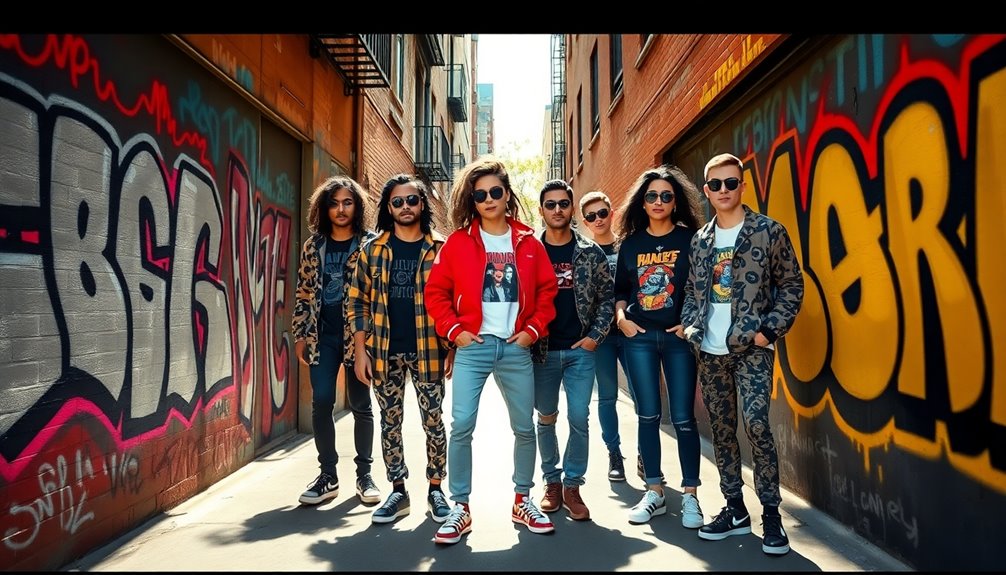
How did street style become the heartbeat of youth culture? In the 1970s, street style emerged as a powerful force, influencing high fashion and allowing you to express your individuality through clothing.
Designers began to draw inspiration from everyday wear, fueling a rebellious spirit among young people. Subcultures like punk, hip-hop, and disco shaped iconic street styles, featuring ripped jeans, oversized silhouettes, and bold patterns.
These unique aesthetics blended into mainstream fashion, creating a more diverse representation within the industry. The accessibility of fashion during this era set the stage for future trends.
Today, the iconic looks of that time, like denim and casual wear, continue to inspire modern styles, proving that street style remains integral to youth culture.
Power Dressing in the 1980s
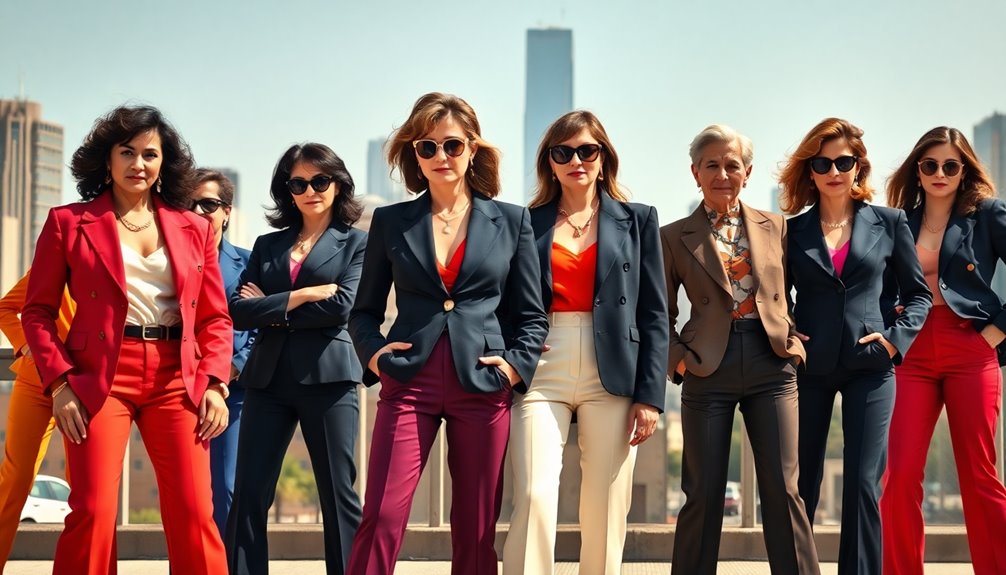
In the 1980s, power dressing transformed how women approached the workplace, with bold silhouettes and sharp tailoring becoming essential.
You saw oversized shoulder pads and structured suits that not only made a statement but also symbolized empowerment and ambition.
This fashion movement challenged the status quo, allowing women to assert their presence in male-dominated spaces. The rise of emotional intelligence in professional environments during this era also contributed to women's success and assertiveness in the workplace.
Bold Silhouettes and Styles
As women stepped into the corporate arena in the 1980s, they embraced bold silhouettes that defined the era's power dressing.
This movement wasn't just about clothing; it symbolized a shift toward equality and confidence. Designers like Yves Saint Laurent and Giorgio Armani crafted looks that combined femininity with authority, making a statement in male-dominated spaces.
Here are four key elements of this iconic style:
- Oversized shoulder pads that added structure.
- Tailored suits that emphasized strong lines.
- Dramatic cuts that exuded confidence.
- A bold color palette that commanded attention.
Power dressing became a visual language, allowing women to assert their presence and ambition in the workplace, leaving a lasting impact on fashion today. The growing emphasis on sustainable grooming practices reflects a broader cultural movement toward eco-consciousness in all areas of life, including fashion and beauty.
Empowerment Through Fashion Choices
Fashion choices in the 1980s became a powerful tool for women seeking to redefine their roles in the workplace. Power dressing emerged as a bold statement, characterized by structured blazers and high-waisted trousers.
With designers like Yves Saint Laurent and Giorgio Armani leading the way, you saw how tailored suits empowered women to assert their presence in male-dominated environments. These outfits didn't just convey professionalism; they allowed you to express your individuality and strength.
This movement aligned with the broader feminist wave, challenging societal norms and expectations. The legacy of empowerment through fashion choices from the 1980s continues today, as contemporary attire often incorporates those bold styles, reminding you of the progress made and the confidence you can embody.
Grunge and Minimalism Trends

While both grunge and minimalism emerged during the 1990s, they represent two distinct yet interconnected approaches to style that captured the spirit of the era.
Grunge, fueled by bands like Nirvana, embraced a rebellious DIY ethos, while minimalism offered a sleek counterpoint prioritizing simplicity.
You can feel the impact of these trends through:
- Flannel shirts and ripped jeans as symbols of rebellion.
- Clean lines and neutral colors promoting calmness.
- Oversized silhouettes reflecting comfort over conformity.
- Iconic supermodels like Kate Moss bridging both worlds.
Together, grunge and minimalism highlighted a cultural shift toward casual wear, allowing you to express authenticity and comfort amid a rapidly changing socio-political landscape. Additionally, just as music therapy can enhance emotional well-being, these fashion movements allowed individuals to embrace their identities through self-expression in their clothing choices.
Fashion became a canvas for self-expression, resonating with today's styles.
Digital Revolution in Fashion
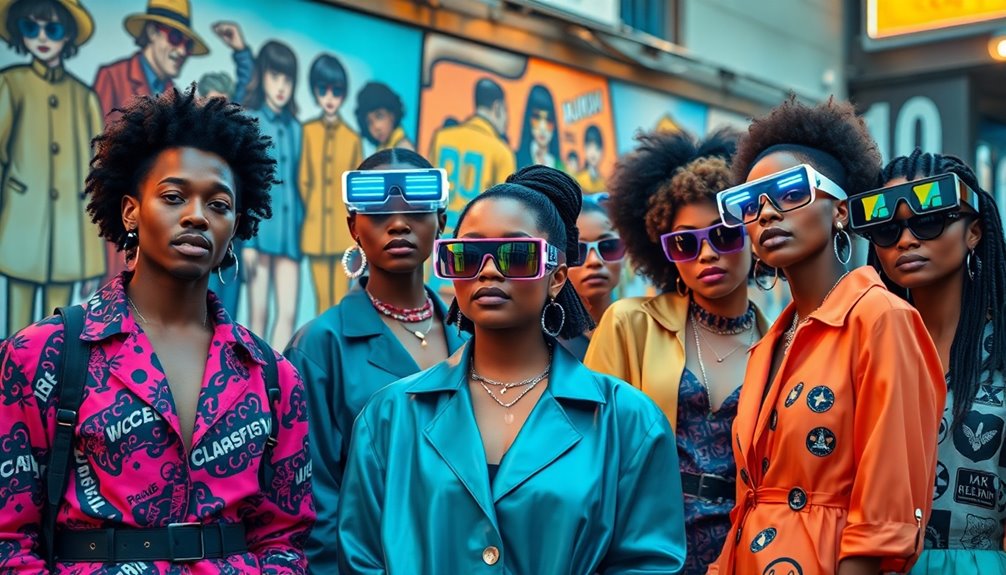
The shift from the 1990s' grunge and minimalism to the digital revolution in fashion marked a significant turning point in how styles are created and consumed.
With social media taking center stage, brands now connect directly with you, showcasing new collections and engaging in real-time conversations.
Online shopping platforms have made fashion more accessible, letting you purchase runway styles from anywhere, anytime.
Influencer culture emerged, where social media personalities shape trends, driving your preferences through collaborations and sponsored content.
Digital fashion shows have transformed presentations, reaching global audiences instantly.
This era also birthed fast fashion, with brands quickly replicating trends to satisfy your desire for instant gratification, ultimately reshaping your shopping experience and the fashion landscape. Moreover, the rise of sustainable fashion has prompted many brands to reconsider their production practices in response to consumer demand for eco-friendly options.
Sustainability and Ethical Movements
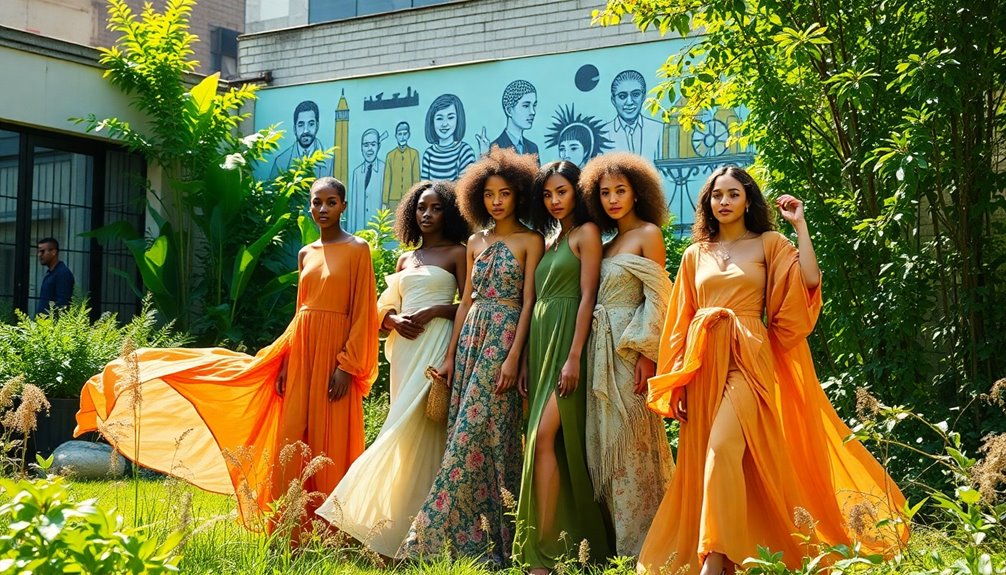
As awareness of environmental issues grows, you're likely noticing a cultural shift in the fashion industry towards sustainability and ethical practices.
Consumers are demanding transparency and responsibility, pushing brands to rethink their methods. Here are some key changes you might find inspiring:
- Designers prioritize eco-friendly materials like organic cotton and recycled fabrics.
- Ethical fashion movements advocate for fair labor practices and humane treatment of workers.
- Events like Fashion Revolution Day urge you to question the origins of your clothing.
- Major brands adopt circular fashion principles, emphasizing recycling and upcycling.
This transformation not only reduces the industry's carbon footprint but also promotes a more conscious approach to fashion. Additionally, monitoring options in the security industry are shifting towards more sustainable practices, reflecting a broader trend across various sectors.
You now have the power to support sustainable and ethical fashion choices.
Frequently Asked Questions
How Has Culture Influenced Fashion?
Culture influences fashion in countless ways, shaping your choices and preferences. As you navigate trends, you'll notice how music, art, and social movements inspire styles.
For instance, the outfits you wear often reflect your beliefs or the era you're influenced by. Whether it's adopting sustainable materials or embracing bold colors, cultural shifts push you to express your identity through fashion, making it a powerful medium for personal and collective expression.
How Does Culture Influence Trends Around the World?
Culture influences trends around the world by shaping what you wear and how you express yourself.
You see styles evolve through music, art, and social movements, reflecting the values and identities of different communities.
When you embrace cultural elements, you connect with their history and significance.
Globalization amplifies this exchange, allowing you to discover and incorporate diverse influences, creating a rich tapestry of fashion that celebrates both tradition and modernity.
How Does Society Shape Our Fashion Choices?
Society shapes your fashion choices in countless ways. You often find yourself influenced by current trends, peer pressure, and cultural values.
When you see celebrities or influencers wearing certain styles, you're likely to adopt those looks. Additionally, societal norms dictate what's considered acceptable or fashionable, pushing you to conform.
Economic conditions and lifestyle changes also play a role, making practicality or extravagance more appealing at different times in your life.
What Was the Role of Fashion in Social Movements?
Fashion's like a loudspeaker for social movements, amplifying voices that often go unheard.
You see, clothing isn't just fabric; it's a canvas for expression. When you don black armbands or don a mini-skirt, you're not just making a style choice; you're making a statement.
As trends evolve, they carry messages of resistance and unity, transforming runways into platforms where your wardrobe can spark conversations about justice, identity, and freedom.
Conclusion
As you explore how cultural movements shaped iconic looks, you'll see that fashion isn't just about clothing—it's a powerful reflection of society. Take the Little Black Dress, for example; it emerged from a time when women sought liberation and independence. Today, as sustainability takes center stage, brands like Stella McCartney lead the charge, reminding us that our choices can influence the future of fashion. So, embrace these movements, and let your style tell a story that matters.


